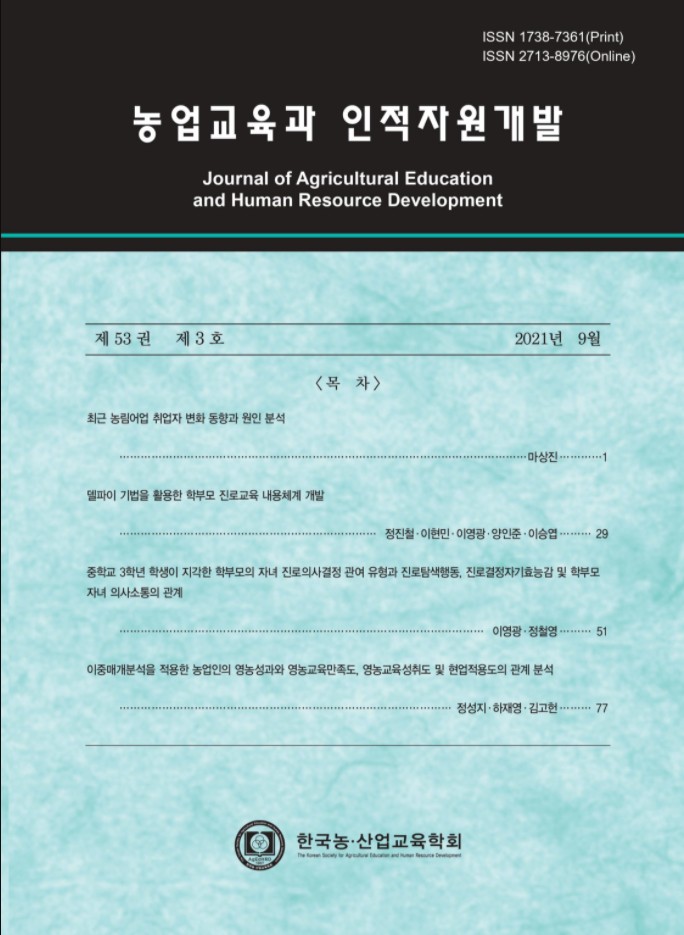중학교 3학년 학생이 지각한 학부모의 자녀 진로의사결정 관여 유형과 진로탐색행동, 진로결정자기효능감 및 학부모 자녀 의사소통의 관계
The Relationship among the Types of Parents’ Involvement in Career Decision-Making, Career Exploration Behavior, Career Decision-Making Self-Efficacy, and Parents-Adolescent Communication Perceived by Third-Year Middle School Students
- 한국농산업교육학회
- 농업교육과 인적자원개발
- 제53권 제3호
-
2021.0951 - 76 (26 pages)
- 60

이 연구의 목적은 중학교 3학년 학생이 지각한 학부모의 자녀 진로의사결정 관여 유형을 구명하고 각 유형과 진로탐색행동, 진로결정자기효능감 및 학부모 자녀 의사소통 간 관계를 구명하는데 있다. 이를 위해, 중학교 3학년 학생 418명의 표본을 분석에 활용하였다. 잠재프로파일분석 결과, 학부모의 자녀 진로의사결정 관여 유형은 부-모 관여 부족형, 모 중심 심리 지지형, 부-모 지지형, 부-모 평균 관여형, 부-모 적극 관여형의 다섯 개로 분류되었다. 다음으로 각 유형과 진로탐색행동, 진로결정자기효능감 및 학부모 자녀 의사소통 간 일원분산분석 결과, 부-모 적극 관여형과 부-모 지지형의 경우, 진로탐색행동과 진로결정자기효능감 및 개방형 의사소통이 높았고 부-모 관여 부족형의 경우 폐쇄형 의사소통이 높았다. 이러한 연구 결과를 바탕으로 연구의 결론 및 제언을 제시하였다.
The purpose of this study is to investigate the types of parents involvement in career decision-making for their children perceived by third-year middle school students, and to investigate the relationship among each type and career exploration behavior, career decision-making self-efficacy, and parents-adolescent communication. To this end, a sample of 418 third-year middle school students was used for analysis. As a result of the latent profile analysis, the parents involvement in career decision-making for their children was classified into five types: parents lack of involvement type, mother support type, parents support type, parents average involvement type, and parents active involvement type. Next, the results of a one-way variance analysis among each type and career exploration behavior, career decision-making self-efficacy, and parent-adolescent communication, in the case of the parents excessive involvement type and the parents support type, the level of career exploration behavior, career decision-making self-efficacy, and open communication level was high, and in the case of the parents intervention type, the level of closed communication was high. Based on these findings, the conclusions and suggestions of the research were presented.
I. 서론
II. 이론적 배경
III. 연구 방법
IV. 연구 결과
V. 결론 및 제언
(0)
(0)